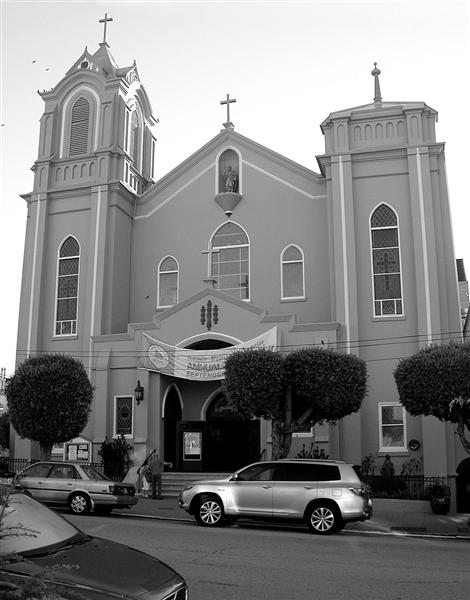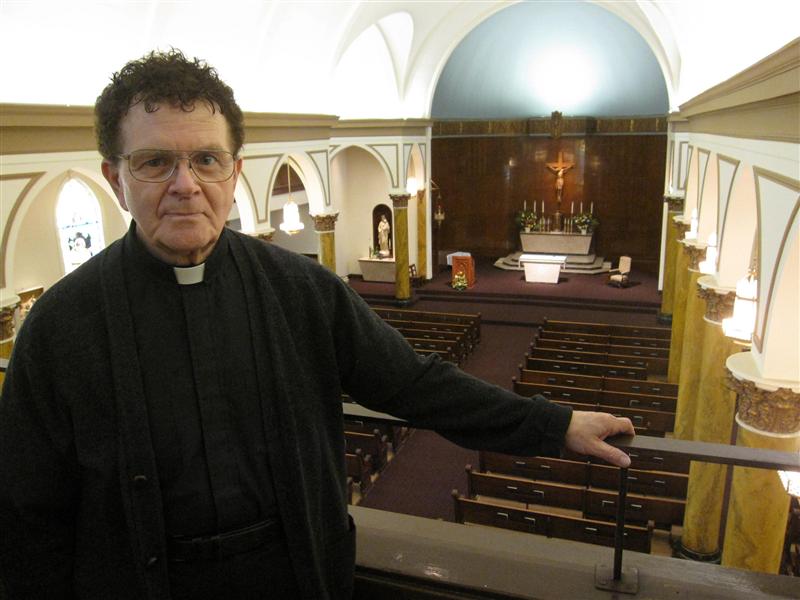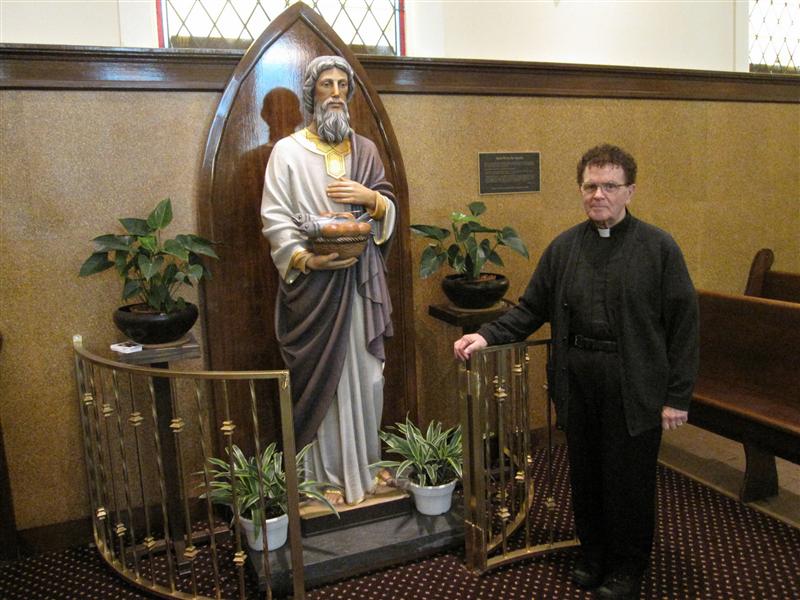
RETURN TO HOME PAGE
FEEDBACK
 |
October 2010 RETURN TO HOME PAGE FEEDBACK |
 |
| St. Philip’s was 15 years young in 1925, when the church built its stately Romanesque building at 725 Diamond Street. Both the exterior and the interior recently underwent a major renovation, which included restoration of 24 stained-glass windows. Photo by Jack Tipple |
By Corrie M. Anders
One hundred years ago, Noe Valley was a fast-growing suburb of downtown San Francisco, still rebuilding in the aftermath of the 1906 earthquake. Though cattle grazed in the shadow of Twin Peaks, the neighborhood was rapidly becoming urbanized. There were wooden sidewalks on 24th Street, nickel pay phones on the corner, and horse-and-buggy taxis available for hire.
What the bustling neighborhood of working-class, mostly Irish residents didn’t have—and badly wanted—was its own Roman Catholic church. In 1910, the Catholic hierarchy granted the community’s wish and planted the seed for what would become a Noe Valley landmark: St. Philip the Apostle Church.
This month, St. Philip Parish celebrates the church’s historic 100th birthday with a centennial mass—a liturgical candle-blowing for a party that has been going on all year.
San Francisco Archbishop George H. Niederauer will deliver the special mass Oct. 17 at St. Philip Church, at Elizabeth and Diamond streets. He also will bless a life-size wooden statue of Saint Philip that was hand-carved in Italy and recently installed in the sanctuary.
The archbishop will praise the church as “an anchor in the Noe Valley neighborhood,” and for ministering to five generations of parish residents. “The centennialÉis a time to remember past blessings, to celebrate contemporary vitality, and to anticipate joyfully the future role of the parish in the lives of parishioners,” Niederauer says.
The anniversary observance will continue Dec. 5, when the St. Philip’s adult choir performs Antonio Vivaldi’s Gloria and the youth choir presents selections from Handel’s Messiah.
Birthday festivities began in the spring with a music concert. The annual St. Philip Parish Festival, held last month, also was dedicated to the centennial. The family-oriented event on Sept. 24-26 drew hundreds of people from throughout the city for three days of dancing, music, games, and a mostaccioli pasta dinner.
Eight Pastors Leading the Flock
Today, approximately 700 families attend services at St. Philip’s. They worship in a building whose Romanesque architecture is embroidered with 24 stained-glass windows, which were milled by French artisans. A green shamrock painted on the sidewalk in front of the building’s entrance is a daily reminder of the church’s Irish heritage.During its long history, St. Philip’s has had eight pastors, all Irish and mostly from the old country—that is until the 2004 arrival of Father Tony LaTorre, a slight, curly-haired cleric whose warmth softens his religious rectitude.
“I’m the first non-Irish pastor of this parish,” says LaTorre, with a smile. The 62-year-old priest, who has Italian ancestry, previously served at St. Charles Church in San Carlos.
Last month, LaTorre and several longtime parishioners—Patricia Del Carlo, Linda Siemers, Theresa Erkkila, and Bill Yenne—gave the Voice an overview of the church’s multi-layered history. They gathered inside the church, which recently underwent a nearly $500,000 renovation. The building’s new burnish would have mightily impressed the original congregants, who first met in an old workshop on 24th Street.

Father Tony LaTorre and the members of St. Philip Parish have vowed to do more community outreach, and will host Open Hand’s senior lunch program next year. Photo by Pamela Gerard An Easy Walk to Church
In 1910, one of the hubs of Noe Valley was at 24th and Douglass streets, two blocks from where the number 11-trolley line terminated at Hoffman Avenue. There were a handful of businesses in the area, but no place of worship for the Catholic devout.
“It was a community of basically working-class people, and they didn’t have a lot of transportation. They needed to have a Catholic church there,” says Erkkila, a 22nd Street resident who joined St. Philip’s nine years after she and her husband moved to Noe Valley in 1971.
The steep hill separating Noe and Eureka valleys dissuaded residents from attending the nearest church, Most Holy Redeemer at Diamond and 18th streets. St. James was downhill more than a mile away at 23rd and Guerrero streets, making for a wearying climb home from the Mission District. “You had to cross three creeks to get to church,” notes Del Carlo, 79, a parish member since moving to Noe Valley in 1953.
The flattest terrain led to St. Paul’s Church in the German immigrant stronghold at Church and 29th streets. It too was a mile-long trek from Diamond Street.
After Archbishop Patrick Riordan gave approval for a local parish, the job to establish the new congregation fell to Father John Cullen, a mild-mannered priest from County Cavan, Ireland.
The relatively small parish was carved from a trio of adjacent Catholic communities. Its borders today are 21st Street on the north, Castro Street on the east, Duncan Street on the south, and Burnett Avenue and Romain on the west.
The new parish was named in honor of Saint Philip the Apostle, one of Jesus’ 12 disciples. The first chapel, albeit a temporary one, was a converted workshop at 4296 24th Street, now the site of the Animal Company pet store. Cullen rented an upper flat a few doors away at 4262 24th Street, which he used as his parochial residence for nearly two years.
St. Philip’s quickly outgrew the space, and parishioners built a new church nearby on Elizabeth Street, which opened in 1914. Cullen later launched a fundraising drive for an even larger church, the current sanctuary, which was erected at a cost of $71,000. The first mass in the present-day building was held in 1925.

A hand-carved wooden statue of Saint Philip the Apostle will receive a special blessing from the Archbishop of San Francisco on Sunday, Oct. 17, as Father Tony LaTorre and the parish’s 700 families celebrate the church’s centennial. Photo by Pamela Gerard Evolving Demographics
Over the next 50 years, Noe Valley experienced two social changes that had a significant impact on the congregation’s makeup, according to a church history, St. Philip’s Diamond Jubilee, published in 1985.
The first, occurring during and after World War II, was an influx of Italian, Mexican, and South American immigrants, many of whom found their way to the church. The second was a wave of singles and young couples, part of the “counterculture” movement of the 1960s and ’70s. Attracted to the warm weather and relatively low-cost housing, the newcomers settled in the neighborhood and began raising families. At one time, Latinos had enough of a presence at St. Philip’s that the church held festivals in December with mariachi music accompanying the mass, to celebrate Our Lady of Guadalupe—a virgin revered in Mexico.
St. Philip’s retains its multicultural flavor. Many Latinos still attend—though in diminished numbers in recent decades—along with a small number of African-American and Filipino worshipers.
The church also has a contingent of gay and lesbian families, says LaTorre. “They’re very active. They get right in there and roll up their sleeves. They’re welcomed.”
School Enrollment Up
When St. Philip’s blossomed in the 1950s and ’60s, so did the affiliated St. Philip School, located next door. Pastor John Cantillon, a colorful but sometimes cantankerous priest, was the driving force behind the school, raising funds with a bingo-type game that attracted players from across the city. (He also, reputedly, donated his own racetrack winnings.)
The K-8 school, at 665 Elizabeth Street, first opened in 1938 with 156 boys and girls. Enrollment hit 300 in the 1980s, but began to decline until LaTorre arrived. “It was 180 when I came here seven years ago, and now it’s 225,” says LaTorre. The school currently has 60 students and a waiting list in its pre-kindergarten program, which started three years ago.
The school also attracts parents to the church. “It’s one of the drawing cards,” says LaTorre. “They might live somewhere else in the cityÉbut they end up becoming parishioners.”
Hot Meals for the Elderly
The contemporary church has a strong social and civic agenda. “We are trying to focus on greater community outreach,” LaTorre says. “We are trying to get away from just our own little congregation and spread out as best we can.”
Seven months ago, for example, the church’s men’s club started a program to deliver hot meals—“no questions asked”—to the elderly, the sick, or anyone facing hunger. A food drive last November and December brought in 9,000 pounds of provisions that were distributed to three charitable organizations.
Next month, St. Philip’s will provide the venue for Project Open Hand’s senior lunch program, which must leave its longtime home at the Noe Valley Ministry. That’s because the Presbyterian Church is scheduled to close for at least a year for major renovations. “I read in the Noe Valley Voice that they were closing” and were seeking an alternative space for the meal program, LaTorre says. “So I made a couple of phone calls, and they accepted the offer. We are excited about the seniors coming over here.”
For the past five years, Boys Hope Girls Hope, a national program that provides stable homes for at-risk children, has operated a house for nine boys in St. Philip’s old school convent. And the church also is deeply involved with the charitable St. Vincent de Paul Society.
“At Thanksgiving, we had a food drive for the entire month, and we collect coats for the wintertime—and we’ll do it again this year,” says Siemers. The congregation also will raise funds for families living in homeless shelters as well as “sponsor” a family during the Christmas holidays.
Proud of Renovations
One of St. Philip’s pearls is its Parish Hall, which underwent a $1 million renovation nine years ago. The 400-capacity facility has become a magnet for community gatherings, ranging from Pavement to Parks workshops to San Francisco History Association meetings. It is also the regular venue for weekly Alcoholics Anonymous and Overeaters Anonymous groups.
“It’s the community spirit of St. Philip’s that I enjoy,” says Siemers, 70, who lives in nearby Miraloma Park. “It’s not only a place where I come to worship, but a place where I come to be with my friends.”
LaTorre ranks the newly refurbished church among his proudest accomplishments. The inspiration came from above.
“We started out with a leaky roof” that became evident during mass, he says. “Of course, when you have a new roof, you have to replace the carpets. That led to painting the interior. And then to look at all this new beautiful painting and carpeting, we had to have a new lighting system. So the outside looked dull, and we had to landscape the outside.”
LaTorre praised the St. Philip’s congregation for reaching “deep into their pockets” to pay for the work.
“Now,” he says, “it looks spic and span.”
Join the Belfry Society
From the time he moved into Noe Valley in 1975, Bill Yenne had always enjoyed the rhythmic peal of the bell at St. Philip Church, which summoned the faithful to worship. Then it dawned on him one day that he had not heard the bell ringing in years.
Yenne and another parishioner, Todd Siemers, climbed into the belfry and discovered that the antique, manually operated bronze bell was broken. That was in 1995.
“I went home [where] I happened to have some motor oil,” said Yenne, an Alvarado Street resident. “We lubricated the axle with 10-30 oil and got it so it moved smoothly.”
Their affection for the bell prompted Yenne and Siemers to establish the St. Philip’s Belfry Society. Yenne, a historian, found that the bell was fabricated in the 1890s, and suspected that it might have been salvaged from another church demolished after the1906 quake.
For several years, the Belfry Society entered a float in the annual St. Patrick’s Day parade, once coming home with a Best Float award.
Volunteers ring the bell 10 minutes before the 10:30 a.m. Sunday mass and before the 5 p.m. Saturday mass. Now, the church is looking for new volunteers to carry on the tradition. If you’re interested, contact St. Philip’s at 282-0141.
—Corrie M. Anders